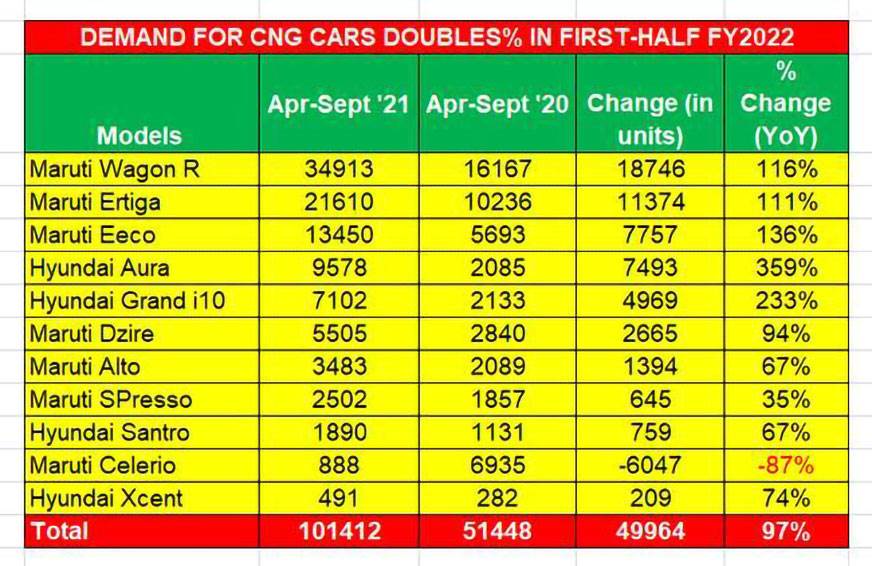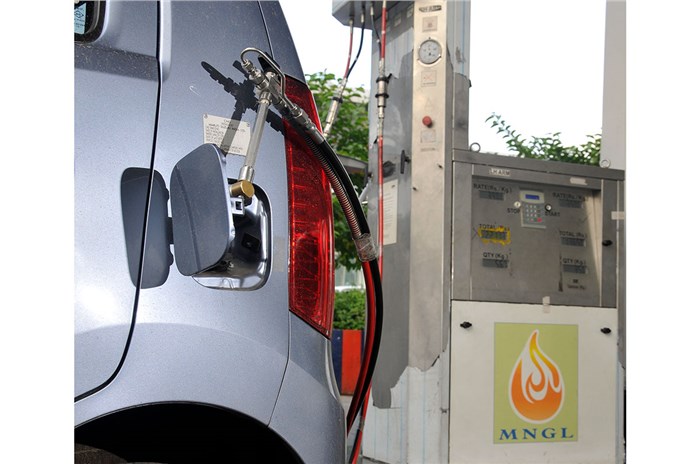Published On Nov 29, 2021 05:06:00 PM
CNG vehicles sales saw a 66 percent year on year growth in the first seven months of FY2022, but could slow if prices continue to rise.
If high petrol (Rs 109.98 a litre) and diesel (Rs 94.14 a litre) prices are not enough, motorists will now have to contend with fast-rising prices of CNG. The Mahanagar Gas Ltd (MGL), one of India’s leading gas distribution companies, has hiked CNG prices to Rs 61.50 per kg effective from midnight of November 26.
- Prices hiked owing to importing CNG to meet demand
- Natural gas global prices have increased
- Price now at Rs 61.50 per kg (Mumbai) from 47.90 per kg at the start of 2021
It is understood that the latest hike is due to MGL sourcing additional market-priced natural gas to meet growing demand of the CNG and PNG (piped natural gas) market in India. Also, global prices of natural gas have increased, leading to MGL’s recent hikes.
This is the third price increase in five months and its fourth this year. The November 26 hike constitutes a 7 percent increase from the Rs 57.54 per kg price on October 4, and is an 18.31 percent increase from the Rs 51.98 per kg on July 13, 2021. The previous hikes this year were on February 8 to Rs 49.40 per kg from Rs 47.90 (when CNG prices were reduced on October 5, 2020). This means in the calendar year to date, CNG prices (in Mumbai) have risen by as much as 28 percent, causing much concern to personal transport owners as well as commercial vehicle operators. And it’s not good news for CNG vehicle manufacturers either.
CNG car sales on the upswing this fiscal
Given CNG’s considerable price difference to petrol and diesel, it is not surprising there is a consumer shift to the greener fuel. A glance at the data table for sales of passenger vehicles reveals the smart rise in demand for CNG vehicles.
Sales of CNG-powered PVs have clocked 66 percent year-on-year growth to 1,19,372 units in the first seven months (April-October) of FY2022. While cars with 77,451 units posted 57 percent growth and accounted for 65 percent of total sales, UVs with 26,783 units notched 90 percent YoY increase and accounted for 22 percent of the share; vans with 15,138 units (up 85 percent) made up the rest with a 12.6 percent share. The much-improved performance of all three sub-segments is reflected in the growing CNG market share in the overall PV segment: cars to 9.87 percent, UVs to 3.50 percent and vans to 24 percent. Overall, the CNG share in the PV market has grown to 7.40 percent from 6.03 percent a year ago.

Both Maruti Suzuki and Hyundai India are extremely bullish on CNG vehicle sales. Of the 11 models on sale, Maruti Suzuki India, with its seven models – Alto, S-Presso, Celerio, Wagon R, Dzire, Ertiga and Eeco – accounts for 82,351 units or 81 percent of the total 1,01,412 units sold in H1 FY2022. The other CNG player, Hyundai, with 4 models – Grand i10, Santro, Aura and Xcent – sold the remaining 19,061 units. While Maruti Suzuki had notched 80 percent YoY growth (H1 FY2021: 45,817 units), Hyundai Motor India has done even better – 238 percent YoY growth (H1 FY2021: 5,631 units), albeit on a lower year-ago base than the overall PV market leader. Tata Motors, which is on a roll in the PV segment with a strong showing month after month, doesn’t have a CNG vehicle in its portfolio yet. But its entry into the CNG segment is imminent.
Growth outlook
While it is difficult to say whether CNG prices will keep moving upwards consistently, given the growing demand for the fuel in India both for motoring and household usage, the fact remains that CNG vehicle running costs are significantly lower compared to petrol or diesel as a CNG vehicle inherently gives better fuel economy when driven on CNG.
A few challenges remain though. Refuelling takes longer due to a fewer number of CNG stations and highway driving requires additional planning in terms of trying to take a route with a CNG station. But car buyers, who have heavy day-to-day usage, find that it makes wallet sense in choosing the CNG fuel option.
There’s also the electric vehicle option. With the central and state governments putting their shoulder to the EV wheel with a host of subsidies and sharpened focus on improving EV charging infrastructure, it is likely the CNG sector’s loss could be the EV segment’s gain.
Also see:
CNG car sales grow 97 percent in April-September 2021
More Maruti Suzuki CNG models in the pipeline
Hyundai Motor India bullish on CNG sales
Maruti Suzuki: Can’t depend only on EV subsidies, need to reduce acquisition costs
Copyright (c) Autocar India. All rights reserved.

